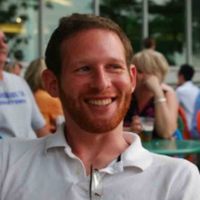Affiliation: California State University, Dominguez Hills

Kenneth E. Seligson is Assistant Professor in the Department of Anthropology at California State University Dominguez Hills, an Honorary Fellow at the University of Wisconsin-Madison, and recently Lecturer with the University of Southern California. He holds his degrees from the University of Wisconsin-Madison (Ph.D. and M.A.) and Brown University (A.B.).
“I am an anthropological archaeologist studying human-environment relationships in the northern Maya lowlands of the Yucatan Peninsula. Specifically, my research has focused on understanding changing resource management practices related to the production of burnt lime in the hilly Puuc region of the Yucatan.”
Since 2009 lidar spatial imagery has been transforming the way that archaeologists approach settlement and landscape studies in the Maya lowlands. Lidar laser technology allows researchers to virtually peel back the dense canopy of the Maya jungle, revealing hundreds of thousands of ancient structures and landscape modifications. Deep in the hilly Puuc Region of the northern lowlands, a recent 240-sq-km lidar flyover has allowed archaeologists to confirm previous suspicions that the north was just as densely populated and architecturally complex as the south. This talk focuses mainly on the large site of Muluchtzekel (c. 500 BCE – 950 CE) and elaborates on the broader implications of the new mapping technology (both its benefits and drawbacks) for understanding changes in human-environmental relationships and socio-political organization over time.
The Classic Maya civilization (200-950 CE), faced many environmental challenges, including those wrought by climate change. Researchers today understand that the breakdown of Classic Maya society was the result of many long-term processes. Yet the story that continues to grip the public imagination is that the Maya civilization mysteriously “collapsed”. In this lecture, I draw on archaeological, environmental, and historical datasets to provide a comprehensive, yet accessible, overview of Classic Maya human-environment relationships that shifts the focus from collapse to resilience.
Over the past twenty years, archaeologists have come to realize that far from being a cultural backwater, the northern lowlands of the Yucatan Peninsula were integral to the development of the ancient Maya civilization. Communities constructed humongous platform mounds around the edges of the hilly Puuc Region as early as 800 BC, at the same time that some intrepid settlers established the first farming villages within the Puuc Region itself. These earliest Puuc agricultural communities followed similar site plans that included central platform mounds and, surprisingly, full-scale ancient Mesoamerican ballcourts. Investigations at the two early ballcourt sites of Xanab Chak and Paso del Macho over the past five years have uncovered amazing ritual offerings including a series of jade pendants and the only known Preclassic Period ceramic figurine from northern Yucatan. This talk will focus on what these very recent findings tell us about the importance of even the smallest communities in the north, and how they will necessitate even further alterations to our understanding of the origins of the ancient Maya civilization.
The Ancient Maya used burnt lime for everything. From the mortar that held their elaborate temple pyramids together to the processing of corn into a nutritious staple food, burnt lime was literally the glue that held the Maya world together. Yet until recently, archaeologists did not know how the Prehispanic Maya made their burnt lime. The amount of wood used in traditional aboveground kilns during the Colonial Period and more recently raised the possibility that burnt lime production may have led to rampant deforestation during the Classic Period. In this lecture, I discuss the many archaeological methods that I used to identify a fuel-efficient Prehispanic pit-kiln technology in the Northern Lowlands – a finding that questions the idea that Classic Maya civilization “collapsed.”
Short bibliography and/or website on lecture topic (for lay reader):
Seligson, Kenneth E., 2019 “What We Can Learn From the Ancient Maya About Facing the Challenges of Climate Change.” The Conversation (Online Publication) (Forthcoming)
Seligson, Kenneth E., Tomás Gallareta Negrón, Rossana May Ciau, and George J. Bey, 2017 “Burnt Lime Production and the Pre-Columbian Maya Socio-Economy: A Case Study from the Northern Yucatán.” Journal of Anthropological Archaeology 48:281–294.